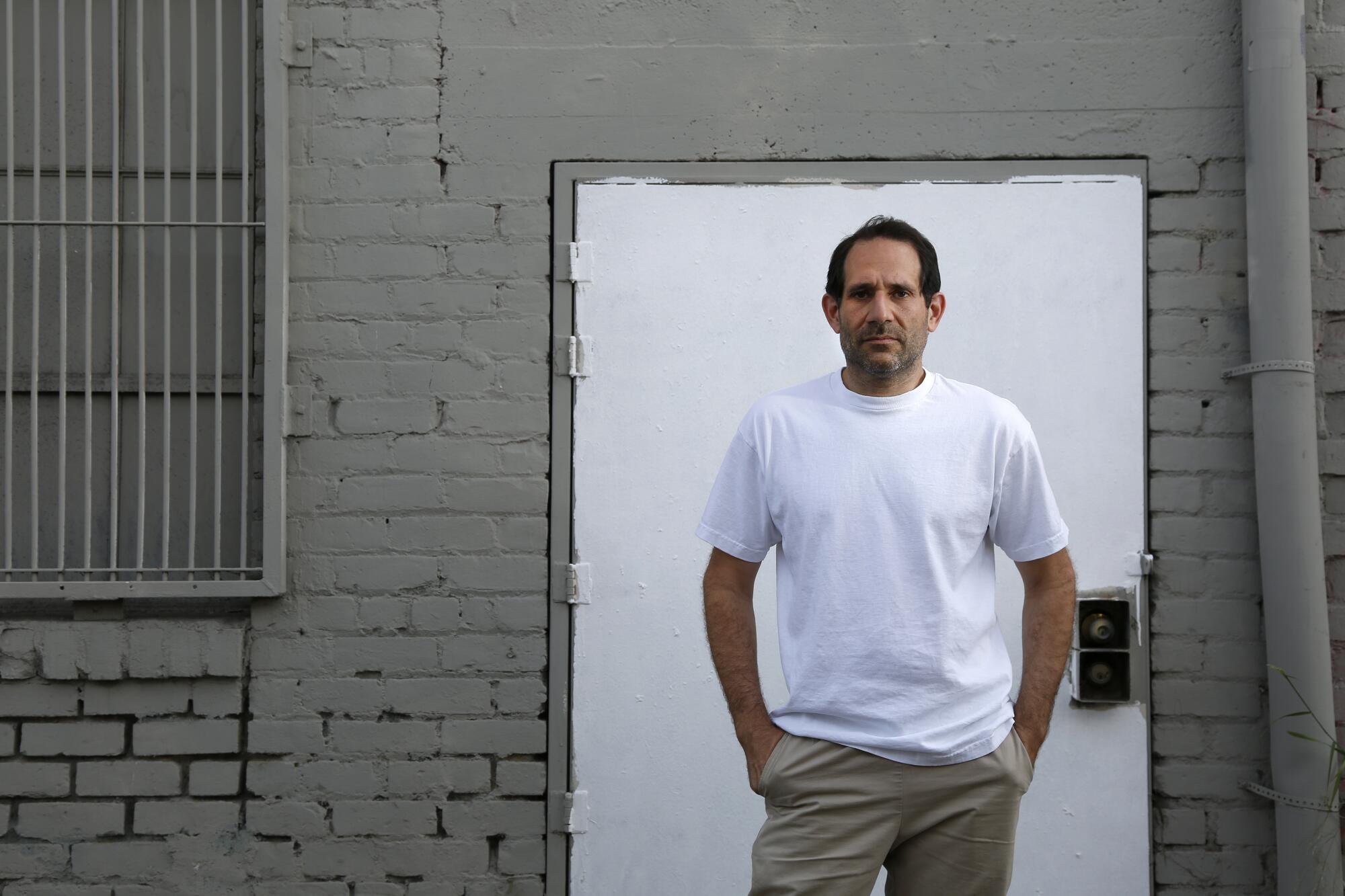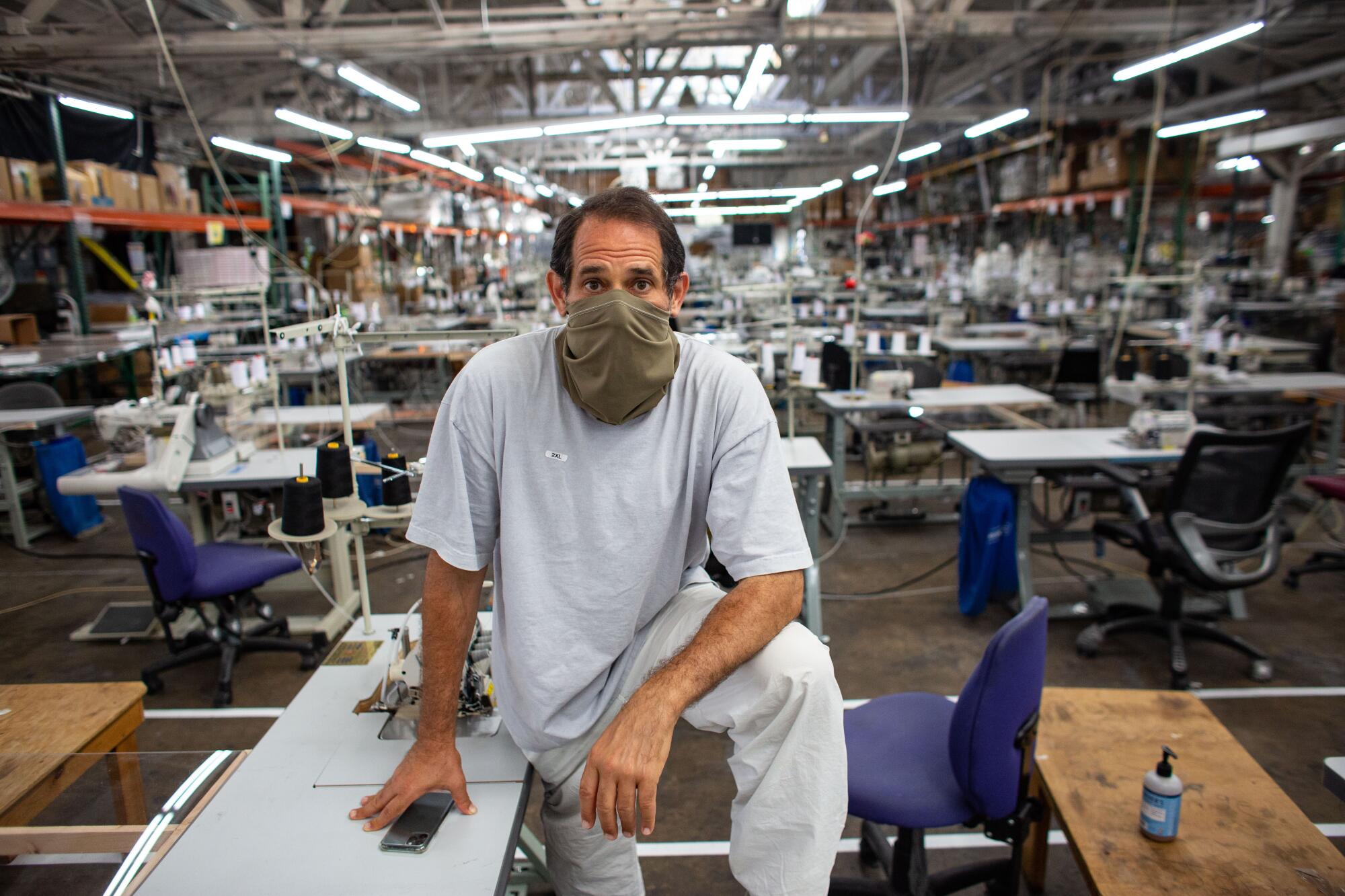
- Share via
The streets of Silver Lake are dotted with historic properties, but none quite like the Garbutt House.
The nearly-century-old residence is sprawling: 11,000 square feet with eight bedrooms and seven bathrooms. At the top of the gated Hathaway Hills Estates community, the home rises above the tidy suburban-style cul-de-sacs to offer 360-degree views of Los Angeles and the reservoir below, with gargoyles standing guard on stone stairways. Thanks to its “eclectic” concrete construction and marbled floors, it’s listed on the National Register of Historic Places.
There’s no question the home is sui generis; what’s up for debate is to whom it belongs.
The Garbutt House is a key piece in the bankruptcy case of fashion entrepreneur Dov Charney, the controversial founder of American Apparel and Los Angeles Apparel. Charney could be booted from the property as soon as next month, when a judge hears arguments over a government-appointed trustee’s motion to clear the home of occupants to prepare it for a sale, with proceeds compensating creditors to whom Charney owes tens of millions of dollars.
Complicating the matter are the additional residents of the property, said the trustee. Court records filed by the trustee show that in addition to Charney and several former American Apparel employees, the property has served as a home to close associates of Ye, the artist formerly known as Kanye West.

Along with his duties as chief executive of Los Angeles Apparel, Charney was reportedly hired this summer as the CEO of Yeezy, Ye’s fashion brand. Charney has been spotted with Ye traveling the world. Charney’s former attorney said he believes his past client was in Europe with Ye in early October.
Also residing at the property is Milo Yiannopoulos, the conservative firebrand in charge of Ye’s political operations as of May, and Ian Connor, a clothing designer accused by numerous women of sexual assault who has long been connected to Ye.
All three were served in the bankruptcy case and listed by Charney as residents. Ye is not mentioned in the bankruptcy proceedings.
The number of residents at the Garbutt House and state of the property have made it difficult to show the house to potential buyers, the trustee in the bankruptcy case said in court papers in support of its motion to recover Charney’s property.
Charney did not respond to requests for comment. His lawyer did not respond to requests for comment. The trustee declined to comment.
Early Hollywood tycoon Frank Garbutt made an unusual choice in constructing his home out of concrete. He chose the material in hopes the structure would outlast earthquakes and floods, but mostly it was to help assuage Garbutt’s fear of fire. There are no fireplaces in the house and where one might expect wood, there is instead concrete or bronze.
The property remained in the Garbutt family after his death in 1947. His daughter sold the estate in 1960. It fell into disrepair and two homes on the property were razed, though the Garbutt House remained. In 1987, the house was designated a landmark on the National Register of Historic Places.
When Charney bought the property for $4.1 million in 2006, American Apparel was booming. Known for its colorful basics and sexy nostalgic sheen, the company had grown to more than 100 stores across the country. Charney at the time was celebrated by the press as a hipster icon and a business leader dedicated to paying garment workers a living wage.

Charney was fired from American Apparel in 2014 over alleged misconduct related to his treatment of women at the company. He had been sued by numerous women for sexual harassment. Charney denied the claims and called his firing unfair. After he was ousted, he told Bloomberg he was down to his last $100,000. Outlets pointed out that he still owned the multimillion-dollar mansion in Los Angeles.
His bankruptcy dates back to financial issues that arose following his ouster from American Apparel. After he was fired, Charney borrowed at least $20 million from New York hedge fund Standard General to mount a bid to retake control of the company he had founded. The bid failed.
Charney still owes more than $20 million to the hedge fund that was ordered paid by a Delaware court in 2017. The hedge fund was seeking the money in Los Angeles County Superior Court when Charney filed for bankruptcy last year, and it remains his biggest creditor.
In the bankruptcy proceedings, Charney listed the Garbutt House on Apex Avenue as his property and residence. He also listed a house on Douglas Street in Echo Park as a property he owns.
The trustee in the case, Brad Krasnoff, has moved for the court to turn over the Garbutt House from Charney to the estate so the trustee can try to sell the property to pay off debts Charney owes.
The trustee did a walk-through of the house in May and realized there were numerous people living on the property, despite Charney stating that he was not leasing or renting to anyone, according to court papers filed by the trustee in support of the turnover motion. The trustee argued that Charney has not cooperated with efforts to show the house in an attempt to sell it.
“The Trustee requires access to the Property, which [Charney] controls. Again, [Charney] has an affirmative duty to cooperate,” wrote Michael D’Alba, an attorney representing the trustee in the case.

Charney’s attorneys have argued against the turnover motion, saying that 17 liens against the property by other people and companies owed money by Charney — including Charney’s uncle and former lawyer — should prevent the trustee from selling it. Simply put, a sale would not generate enough money to even pay back the liens on the house, much less benefit the creditors in the bankruptcy proceeding, Charney’s lawyers argued.
Eliza Ghanooni, a Los Angeles bankruptcy attorney not involved in this dispute, said it is a trustee’s responsibility to liquidate Charney’s assets to pay off creditors. Dealing with liens is a normal part of a trustee’s duties, she said. She also said a trustee has the option to file a motion to sell the house first and subsequently deal with the liens.
“This is pretty standard stuff,” she said.
A judge will hear arguments on the turnover motion Nov. 14.
Charney’s attorneys said he is cooperating with the trustee, but the trustee disagrees.
“The Trustee is frustrated that this is taking too long. The broker was employed to list the Apex property 3 and a half weeks ago, and we still don’t have access,” Eric Israel, an attorney for the trustee, wrote in an Aug. 5 email to Charney’s attorney. “We need cooperation now.”
Charney appeared to acquiesce when he responded Aug. 6.
“We can provide access immediately when the broker needs it. Any reasonable warning will be accepted. Keeping the place organized and getting a cleaning lady the day before is a phone call for me. No dogs will be present during any visit nor any evidence thereof. (The dogs only stay in the basement at this time and the will not be at the home during any visit). No kittens reside at the home,” he said.
But since then, the trustee said in court papers in support of the turnover motion, Charney has continued to ignore stipulations that would allow for access to the property.
“Turnover is appropriate in light of what was observed on the Trustee’s first and only visit to the Property: dogs, cats, and the belongings of multiple occupants strewn about throughout the Property, including multiple bottles of alcohol and ashtrays with cigarette ends,” wrote the trustee’s attorney in a Sept. 20 filing.
A real estate associate with Sotheby’s hired to show the property to potential buyers seemed confused by the entire situation.
“I haven’t been able to show it to people,” said the associate, Eric McCollum. “I actually don’t know what’s going on... I guess [Charney] is able to keep it. I heard he is not moving out. The last I heard is he doesn’t have to move out so he doesn’t need to show it to us.”
A steep, winding driveway leads up to the property on Apex Avenue. On an October day, an Amazon worker sat outside in the driveway after delivering packages and a worker hauled full black trash bags up and down the steps leading to the house.
No one answered the door when a reporter for The Times knocked, but there were two packages outside addressed to Yiannopoulos: a large brown box from a company that makes audio equipment as well as a smaller package from Coddies, a company that makes novelty flip-flops in the shapes of fish and other objects.
Yiannopoulos is a right-wing provocateur who once worked for the news site Breitbart. He gained notoriety for his controversial appearances on college campuses across California. His stops at UC Davis, UC Berkeley and Cal State Fullerton in 2017 led to large counter-protests and even some arrests. Largely out of the spotlight for the last five years, Yiannopoulos was hired in May as Ye’s “director of political operations,” according to the Daily Beast.
Yiannopoulos would not say whether he lived in the Garbutt House or if the home had any connection to Ye, but he challenged a reporter’s “audacious and impertinent” requests when asked about Charney and the bankruptcy case. He also called the reporter’s recent work “maudlin.”
“What subject could be bleaker or more distasteful than someone else’s finances?” he texted. “Except one’s own, of course.”
“I promised my astrologer that October would be positive vibes only,” he said, before cutting off communication.
The other Ye associate, Ian Connor, who used to model for Yeezy and was cited as a fashion muse to the famous Chicago musician, also appears to live in the house. He was served as one of the seven guest occupants residing at the Garbutt House, though the process server spelled his last name “Conner” instead of “Connor.” Connor’s Instagram profile photo is an image of Charney, and a music video he retweeted in June was shot at the Garbutt House.
Connor’s current relationship with Ye is unclear; Ye did not respond to requests for comment through an employee. Last year, Connor helped the artist distribute “White Lives Matter” T-shirts in Skid Row in Los Angeles.
Connor was disavowed by many in fashion after he was accused by multiple women of sexual assault, but he has continued to work in the industry, running a brand called Born From Pain. Connor did not respond to a request for comment. In the past, he has denied allegations of sexual assault.
For Ye, backlash over his offensive outbursts in recent years has lost him his lawyers, his management and some business partners. He has swung far to the right, embracing conspiracy theories and issuing antisemitic rants. Increasingly isolated, he has turned to other controversial figures including his three associates living in the Silver Lake home.
Charney informed the trustee that in all, there were seven guests residing at the property. Besides the Ye associates, two former American Apparel employees were also living at the property.
The house has a revolving door policy, according to Pan Pan, a fabric and clothing manufacturer who stayed at Charney’s home this year while visiting California. He did not speak with other people in the house much but said that there were often five or six others staying there at a time. Pan stayed at Charney’s for about a month over the course of three separate stays, he said.
“I come straight to my room, go to kitchen, then just go to work,” Pan said.
But he eventually became uncomfortable with the communal living.
“I am not comfortable to share same bathroom with someone else. It makes me nuts,” he said. “This place is like a dorm... It’s people in and out.”
More to Read
Sign up for This Evening's Big Stories
Catch up on the day with the 7 biggest L.A. Times stories in your inbox every weekday evening.
You may occasionally receive promotional content from the Los Angeles Times.














